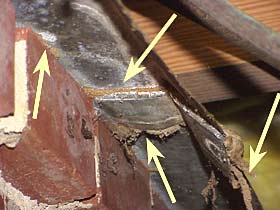Why is the pest report so important? Most lenders require you to show that the
property has no Section I damage before they will agree to make a loan on the property.
This is called "the clearance." If the inspector finds no Section I damage the report
will include the statement that "this property is clear of ..." If the inspector does
find Section I damage, the repairs are made, the inspector comes out again to verify the
repairs and then issues a report which says there is no damage. This report is called the "clearance."
 Each finding listed in the report is followed by a recommendation from the inspector. The
report will title each recommendation with one of 5 titles: Section I, Section II, Further
Inspection, Information or Consult Other Trade.
Each finding listed in the report is followed by a recommendation from the inspector. The
report will title each recommendation with one of 5 titles: Section I, Section II, Further
Inspection, Information or Consult Other Trade.
Section I means "Damage has occurred, corrective action is needed" -- there is evidence of
active infestation or infection damage that has resulted in or from infestation or infection.
Typically sellers are responsible for correcting these items.
Section II means "Damage can be expected in the future, but with corrective action it can
be prevented" - there is a condition that is likely to lead to infestation or infection but
no visible evidence was found as of the time of the report. Typically, buyers agree to assume
responsibility for Section II repairs, although there is no requirement that these be completed
within any particular time frame.
Further Inspections means "there may be damage but it is not readily visible" - To verify whether
or not there is damage will require opening a wall, lifting a floor, moving the current
occupant's personal belongings, etc. You can request that the further inspection be done, for
an additional fee, and a supplemental report will be issued. Who pays for the further inspection
is typically handled as follows: If no Section I damage is found, the buyer pays. If Section I
damage is found, the seller pays for the inspection and for the repairs.
Information - the item is noted for your information only. These are typically reminders as to
future preventative maintenance which you should take.
Consult Other Trade or Another Craft - this means that there was a problem noted, but it is beyond
the scope of the inspector and so should be looked at by a specialized craftsperson.
